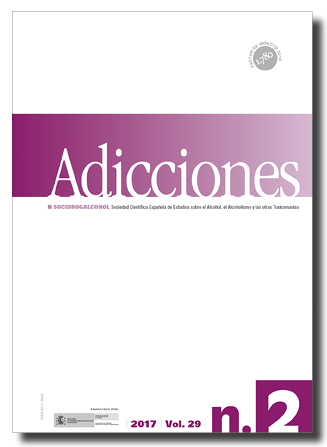Evaluación de los niveles de dependencia de la nicotina en usuarios de cigarrillos electrónicos
DOI:
https://doi.org/10.20882/adicciones.905Palabras clave:
Cigarrillo electrónico, Dependencia de la nicotina, Fumar cigarrillo de tabaco, Dejar de fumar.Resumen
Los cigarrillos electrónicos son dispositivos electrónicos de liberación de nicotina (DELN) incombustibles que mimetizan la experiencia de fumar tabaco (Harrell, Simmons, Correa, Padhya, y Brandon, 2014). Constan de tres elementos principales: una batería recargable, un atomizador y un cartucho. Desde su introducción al mercado en el 2003, su prominencia y uso han incrementado notablemente a nivel mundial (Martínez-Sánchez et al., 2014). Los datos recientes sobre la prevalencia de los cigarrillos electrónicos en muestras europeas y americanas indican que, hasta la fecha, casi el 6,8% de adultos usa los cigarrillos electrónicos (McMillen, Gottlieb, Shaefer, Winickoff, y Klein, 2015). No obstante, esta popularidad creciente ha generado un debate en la salud pública respecto de su seguridad y efectividad como alternativa de cesación tabáquica (Yu et al., 2016).Citas
Cobb, C. O., Hendricks, P. S. y Eissenberg, T. (2015). Electronic cigarettes and nicotine dependence: evolving products, evolving problems. BMC Medicine, 13, 119. doi:10.1186/s12916-015-0355-y.
Foulds, J., Veldheer, S., Yingst, J., Hrabovsky, S., Wilson, S. J., Nichols, T. T. y Eissenberg, T. (2015). Development of a questionnaire for assessing dependence on electronic cigarettes among a large sample of ex-smoking E-cigarette users. Nicotine & Tobacco Research, 17(2), 186-192. doi:10.1093/ntr/ntu204.
Harrell, P. T., Simmons, V. N., Correa, J. B., Padhya, T. A. y Brandon, T. H. (2014). Electronic nicotine delivery systems (“e-cigarettes”): review of safety and smoking cessation efficacy. Otolaryngology Head Neck Surgery, 151(3), 381-393. doi:10.1177/0194599814536847.
Heatherton, T. F., Kozlowski, L. T., Frecker, R. C. y Fagerstrom, K. O. (1991). The Fagerstrom Test for Nicotine Dependence: a revision of the Fagerstrom Tolerance Questionnaire. British Journal of Addictions, 86, 1119-1127.
Marsot, A. y Simon, N. (2015). Nicotine and Cotinine Levels with Electronic Cigarette: A Review. International Journal of Toxicology. doi:10.1177/1091581815618935.
Martínez-Sánchez, J. M., Ballbè, M., Fu, M., Martín-Sánchez, J. C., Saltó, E., Gottlieb, M.,… Fernández, E. (2014). Electronic cigarette use among adult population: a cross-sectional study in Barcelona, Spain (2013–2014). BMJ Open, , 4, e005894. doi:10.1136/bmjopen-2014-005894.
McMillen, R. C., Gottlieb, M. A., Shaefer, R. M., Winickoff, J. P., y Klein, J. D. (2015). Trends in Electronic Cigarette Use Among U.S. Adults: Use is Increasing in Both Smokers and Nonsmokers. Nicotine & Tobacco Research, 17, 1195-1202. doi:10.1093/ntr/ntu213.
Organización Mundial de la Salud. (2014). WHO report on the electronic nicotine delivery systems, 2014: Conference of the parties to the WHO framework convention on tobacco control. Retrieved at http://apps.who.int/gb/fctc/PDF/cop6/FCTC COP6 10- en.pdf, July 8, 2016.
Shiffman, S., Waters, A. y Hickcox, M. (2004). The nicotine dependence syndrome scale: a multidimensional measure of nicotine dependence. Nicotine & Tobacco Research, 6, 327-348. doi:10.1080/1462220042000202481.
Yu, V., Rahimy, M., Korrapati, A., Xuan, Y., Zou, A. E., Krishnan, A. R.,… Ongkeko, W. M. (2016). Electronic cigarettes induce DNA strand breaks and cell death independently of nicotine in cell lines. Oral Oncology, 52, 58-65. doi:10.1016/j.oraloncology.2015.10.018.








